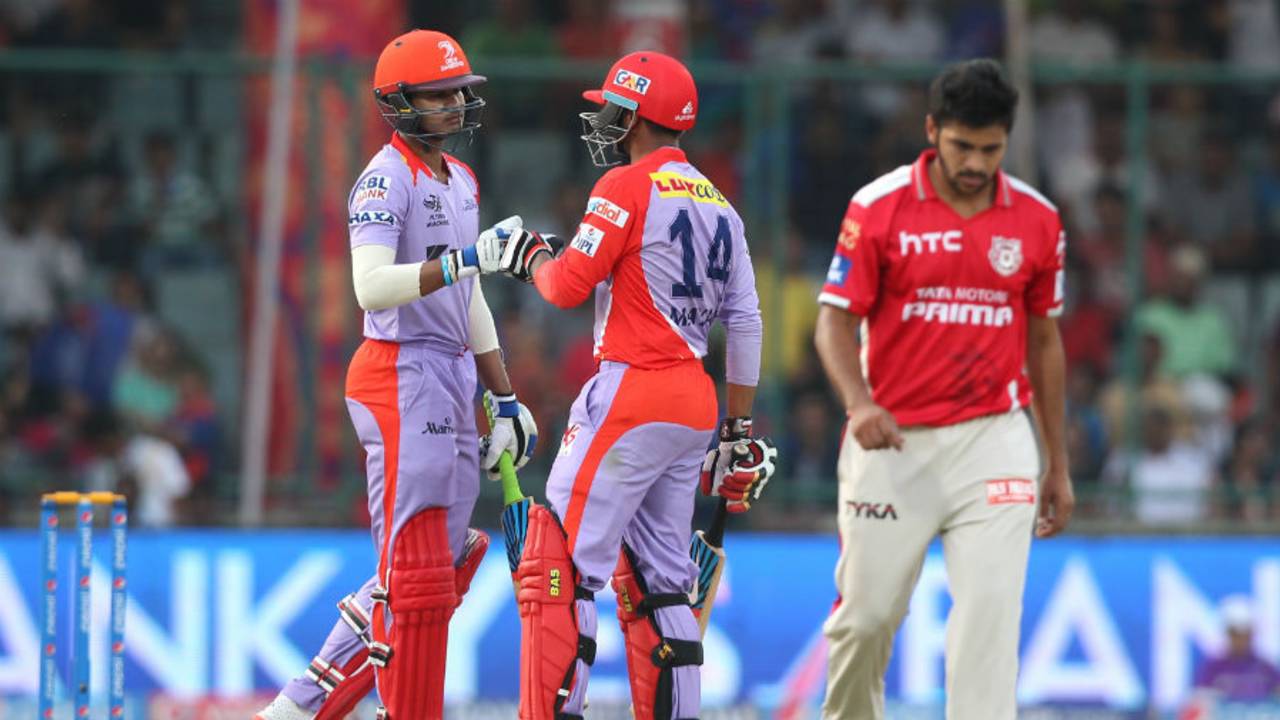"Look, people have already started leaving." Thisara Perera had been caught at deep square leg, pulling yet another ball that didn't come on as expected, breaking Kings XI Punjab's last recognised pair. It was 46 for 6 in the 10th over, and even as David Miller and Axar Patel looked to repair the innings people had begun to talk about leaving. By about 5.30 pm, 90 minutes into the match, quite a few - a hundred perhaps - had walked to the top edge of the stands in the north end of Feroz Shah Kotla and began to watch football in the adjoining Ambedkar Stadium. They cheered on as the incisive playmaker in the No. 15 red jersey that said "Young Boys" went past white jersey - SPCL inscribed on each - after white jersey to set up two goals in the first 15 minutes.
Damn. Even this game was one-sided. People began to leave by the end of the second over of the chase, which was a matter of small relief for the Delhi traffic police as a major portion of the road alongside Kotla has been dug up for Metro work. It is not the relief IPL organisers want.
Had this been Kolkata or Bangalore or Chennai or to a lesser extent Mumbai, the supporters there would have stayed on till the end to celebrate a one-sided home win. Other than those centres no IPL team has been able to build a strong connect with its local crowds. Fans come to these venues not to cheer the home team on but to dance, sing, eat, watch the big stars play no matter the team, and, most importantly, watch a close match. The greatest trick T20 ever played was to shorten the game so much that the difference in the quality of the teams doesn't show too much. The matches are usually closer than the longer formats.
There is only one glitch, though: you don't want pitches to misbehave too much. In a game so short the argument that the pitch is same for both teams doesn't quite hold. The side that bats first doesn't quite get the time to asses the conditions and then reassess the total they should aim for, by which time usually you can be four-five down because you have to play aggressive shots in T20. And then the chasing side can plan its innings much better without the pressure of going for quick runs.
The pitch for this match was a tricky one, one that leads to one-sided Twenty20 matches. It did bring the hosts Delhi Daredevils much joy, but it could easily have been them at the receiving end - they scored 95 in the last game here - had they lost the toss. From ball one, with people peering in to watch a contest between the two great Test hands for India in the 2000s, Zaheer Khan and Virender Sehwag, the pitch made its treacherousness felt. Sehwag saw a short-of-a-length ball, outside off, looked to push at it, but the ball didn't come on. Ball two was same, and Sehwag was not lucky this time, with the thick edge resting with short cover-point, a good field placement for a two-paced pitch.
Soon the dual bounce would become apparent too. In Zaheer's second over, Manan Vohra had to deal with a shooter, which skid through and came on quicker than the previous deliveries. Two balls later, having faced five dots out of six already, he stepped out and saw this ball kick at him from a similar length. Zaheer seemed to have run his fingers on this, which might have been good reading of a dry surface, but the variance in bounce was a bit much for a two-over old ball.
In between the two wickets, which can be credited to the pitch, Kings XI had lost Shaun Marsh, a wicket that the pitch didn't have much to do with. He just played an ordinary shot across the line to a full offbreak, and even if the angle had saved him from the lbw - it didn't - his doziness would have had him run out anyway. In the next over, with Nathan Coulter-Nile hitting the pitch even harder than Zaheer more uneven bounce showed. The first ball - short and outside off - stayed low to beat the under edge, and the next - a touch fuller than before - reared at Wriddhiman Saha. A confused Saha got out next ball, poking at one outside off, and at 10 for 4 Kings XI were hardly in any state to reassess their way to a competitive total.
The two men who took on the rebuilding job - Miller and George Bailey - didn't show enough confidence in their footwork to take the wily Amit Mishra on, and weren't great on the sweep either, which eventually consumed Bailey. There is no doubt Daredevils assessed the conditions better, there is no doubt Kings XI didn't play spin well, but you don't want to see so much unevenness in a Twenty20 pitch. Test the batsmen all you want with movement and good bounce, but it's when the ball begins to go through the surface or sit up - sometimes one after the other - it doesn't make for a close match, the currency of Twenty20.
Some exceptional batsmen - the likes of Michael Hussey - can assess T20 conditions in two or three balls and reassess the total they want accordingly, some freaks - the likes of Glenn Maxwell - can sometimes get into a zone where they connect everything no matter the variance in bounce, but unfortunately for the crowd at Kotla no such events occurred. The football match at Ambedkar Stadium, too, was one-sided.
Sidharth Monga is an assistant editor at ESPNcricinfo
